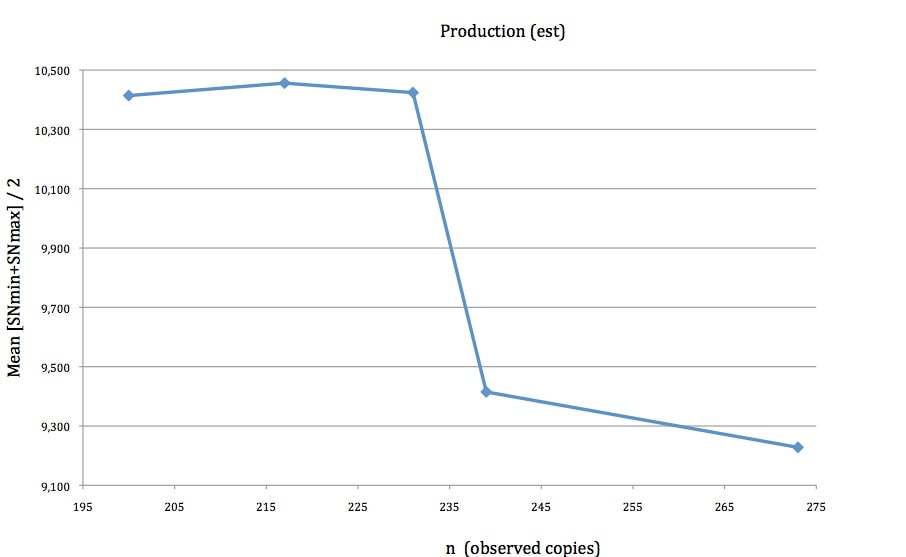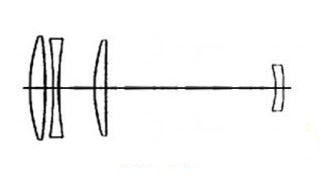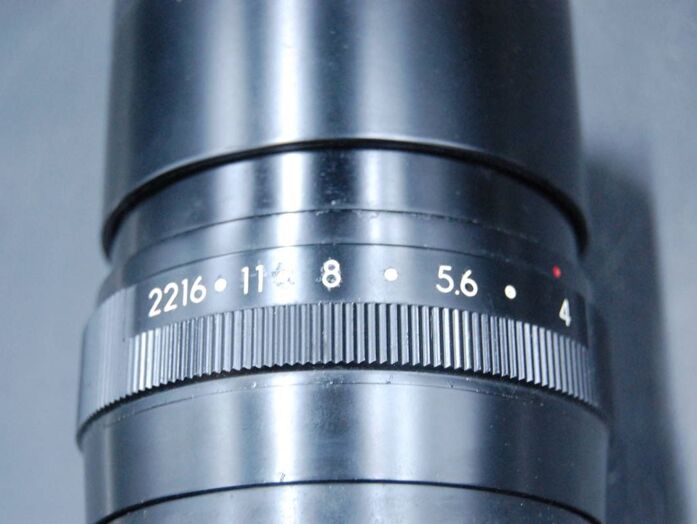T a k u m a r 1 : 4 f = 3 0 0mm / T a k u m a r 1 : 4 / 3 0 0 Model II
Produced 1962 to 1966. Serial Number range 4171xx - 21569xx. AOCo Product No.346 . Honeywell Pentax Cat.No.729. Updated April 2023
Produced 1962 to 1966. Serial Number range 4171xx - 21569xx. AOCo Product No.346 . Honeywell Pentax Cat.No.729. Updated April 2023
(Research Note: Since 2010 I have seen 2.96% (273 copies) of the total estimated 9,300 copies made.)
INTRODUCTION
An attractive but heavy manual lens with a new optical design that lives up to its promise. An extra glass element compared with the previous model, gave it 4 elements in 4 groups to become the heaviest of it's type (> 1,500g). Nevertheless, it performs well and became five times more popular than it's predecessor. Its good looks and large well-spaced rubberised grips with fine striations on both adjusting rings make it easy to use.
It shares the fixed rotating tripod mount of Model I and gains a fixed extendable hood that is easier to use (than the detachable threaded version of the earlier model). It is the first 300mm Takumar with a product number and looks similar to the smaller preset Takumar 1:3.5 200mm. It's solid; just light enough to carry around and still fun to use, even without a tripod.
This lens changed cosmetically during production. An eleventh hour face-lift in 1966, from product number 346 to 43460 with an extra stop (f=32) on the aperture ring added, gave it a more modern look. Its tiny successor (in comparison), the automatic Super-Takumar 1:4/300mm being launched at that time (with a minimum aperture of f=22), would have been more than enough competition.
An attractive but heavy manual lens with a new optical design that lives up to its promise. An extra glass element compared with the previous model, gave it 4 elements in 4 groups to become the heaviest of it's type (> 1,500g). Nevertheless, it performs well and became five times more popular than it's predecessor. Its good looks and large well-spaced rubberised grips with fine striations on both adjusting rings make it easy to use.
It shares the fixed rotating tripod mount of Model I and gains a fixed extendable hood that is easier to use (than the detachable threaded version of the earlier model). It is the first 300mm Takumar with a product number and looks similar to the smaller preset Takumar 1:3.5 200mm. It's solid; just light enough to carry around and still fun to use, even without a tripod.
This lens changed cosmetically during production. An eleventh hour face-lift in 1966, from product number 346 to 43460 with an extra stop (f=32) on the aperture ring added, gave it a more modern look. Its tiny successor (in comparison), the automatic Super-Takumar 1:4/300mm being launched at that time (with a minimum aperture of f=22), would have been more than enough competition.
DESCRIPTION
An attractive but heavy all black lens with a manually operated aperture. The optical formula is 4/4 and it's quite sharp, as the maker claims to justify the weight. Compared with Model I it is wider and longer by 10mm; heavier by 250g; but easier to use, because the adjusting rings are further apart, larger and rubberised. The controls are more accessible and feel different. It's a solid lens from the impressive-looking lens era. For people with big hands who can carry it and like taking faster shots of far subjects it's a joy, still.
These early rubber grips are a unique among Takumars; a feature that characterises this lens ahead of it's time. Abandonment of traditional coarse-knurled metal grips came slowly. Other soft materials next appeared on the large one-touch grips of the Takumar-Zooms using a different harder material. Non-metal grips came into vogue with the synthetic materials used on SCM TAKUMARS in the 1970's so that lenses were lighter and cost less.
These early rubber grips are a unique among Takumars; a feature that characterises this lens ahead of it's time. Abandonment of traditional coarse-knurled metal grips came slowly. Other soft materials next appeared on the large one-touch grips of the Takumar-Zooms using a different harder material. Non-metal grips came into vogue with the synthetic materials used on SCM TAKUMARS in the 1970's so that lenses were lighter and cost less.
|
Source: Takumar History
|
It has at the same fixed rotating tripod bush as Model I operated by a chromium-plated, winged screw. The texture of the matt finish on later copies is finer.
This lens is heavy. It weighs over 1,500g without filters or caps; an average of 1547g (n=4). Two of the earliest copies (SN 417313 and 904632) weigh 1583g and 1547g respectively. Later copies (SN 1248358 and 2118896) have tripod mounts with pin-location holes (?) making them a little lighter at 1534g and 1523g.
This lens is heavy. It weighs over 1,500g without filters or caps; an average of 1547g (n=4). Two of the earliest copies (SN 417313 and 904632) weigh 1583g and 1547g respectively. Later copies (SN 1248358 and 2118896) have tripod mounts with pin-location holes (?) making them a little lighter at 1534g and 1523g.
Feet 500 200 150 100 70 50 40 35 30 25 20 18
Meter ∞ 100 50 30 20 15 12 10 9 8 7 6.5 6 5.5
Meter ∞ 100 50 30 20 15 12 10 9 8 7 6.5 6 5.5
o
2216 . 11 . 8 . 5.6 . 4 (Batches 1-25; 10 available settings)
322216 . 11 . 8 . 5.6 . 4 (Batches 26-37; 11 available settings)
2216 . 11 . 8 . 5.6 . 4 (Batches 1-25; 10 available settings)
322216 . 11 . 8 . 5.6 . 4 (Batches 26-37; 11 available settings)
| | | | | l | | | | |
Batches / / / | \▲/ | \ \ \ DOF gauge styles
( 1 - 9 ) 22 16 11 8 4 8 11 16 22 9 f stops
R|/ / / | \▲/ | \ \ \
( 10 - 18 ) 22 16 11 8 4 8 11 16 22 9 f stops
R| | | | | ▲ | | | |
( 19 - 25 ) 22 11 5.6 11 22 5 f stops
R| | | | | ▲ | | | | |
( 26 - 37 ) 32 22 11 5.6 11 22 32 7 f stops
Batches / / / | \▲/ | \ \ \ DOF gauge styles
( 1 - 9 ) 22 16 11 8 4 8 11 16 22 9 f stops
R|/ / / | \▲/ | \ \ \
( 10 - 18 ) 22 16 11 8 4 8 11 16 22 9 f stops
R| | | | | ▲ | | | |
( 19 - 25 ) 22 11 5.6 11 22 5 f stops
R| | | | | ▲ | | | | |
( 26 - 37 ) 32 22 11 5.6 11 22 32 7 f stops
Cases similar to those used for Model I without the filter compartment were made initially (batches 1-10). Then black leather and green interiors became fashionable (approximately batches 10-15). The new "D section" cases arrived with the AOCo logo on the top and the country of origin stamp below the hinge arrived (approximately batches 15 - 26). During the last transformation of the lens "TAKUMAR" replaced the logo on top of cases (batches 26-37). Changes in case types shadow the timing of changes in the lens.
The chrome plated silver locking screw for the tripod mount of this model is interchangeable with the black anodised locking wheel with the knurled grip made for Super-Takumar versions for those who prefer the all black look.
This model is included in the Asahi Pentax Service Manual.
Cases similar to those used for Model I without the filter compartment were made initially (batches 1-10). Then black leather and green interiors became fashionable (approximately batches 10-15). The new "D section" cases arrived with the AOCo logo on the top and the country of origin stamp below the hinge arrived (approximately batches 15 - 26). During the last transformation of the lens "TAKUMAR" replaced the logo on top of cases (batches 26-37). Changes in case types shadow the timing of changes in the lens.
The chrome plated silver locking screw for the tripod mount of this model is interchangeable with the black anodised locking wheel with the knurled grip made for Super-Takumar versions for those who prefer the all black look.
This model is included in the Asahi Pentax Service Manual.
VARIATION
- A study of variation in appearance is found at this site (J). Copies in the first two batches have all white lettering and SN's that carry a prefix.
- Some early copies in the first batch have a wider finger grip in which the full aperture setting scale is inset. A copy is illustrated in some lens manuals.
NOTES
- Copies with a cut-away front aperture grip appeared in sales brochures and in batches 1 and 2. Later the finger grip was reduced in width from what appears to have been a before-market style. Early AOCo literature often includes photographs of lenses in development. This photograph shows a pre-production copy with a broad aperture grip twice that of a production copy. In the photograph the aperture scale occupies a notch, or cutout section within the leading edge of it's broad rubberised grip. Production copies have regular narrow grips half the width and don't enclose the scale. I have not seen any such pre-production copies.
LENS PRODUCTION (∑ lenses) ∑n =273 serial numbers (SN) observed in 48 batches covering 5,056 SN min.< ∑ lenses < 13,400 SN max.
SN min. = accumulated total of serial numbers observed within 48 batches
SN max. = accumulated total of serial numbers observed between adjacent batches of other lenses.
Styles: 10 or 11 available aperture settings with 4 large white dots marking half stop positions
▼ SN prefix "No" ▲/▼▼ White distance scales. No IR marker.▲▲/▼▼▼Large lettering (Futura) bi-coloured distances scales. IR marker.▲▲▲
DOF guide 9 or 5 f stops ▼▼▼▼Min. aperture f=22▲▲▲▲ 10 settings
DOF guide 7 f stops ▼▼▼▼▼Small lettering (Helvetica) Min. aperture f=32 ▲▲▲▲▲ 11 settings .
SN min. = accumulated total of serial numbers observed within 48 batches
SN max. = accumulated total of serial numbers observed between adjacent batches of other lenses.
Styles: 10 or 11 available aperture settings with 4 large white dots marking half stop positions
▼ SN prefix "No" ▲/▼▼ White distance scales. No IR marker.▲▲/▼▼▼Large lettering (Futura) bi-coloured distances scales. IR marker.▲▲▲
DOF guide 9 or 5 f stops ▼▼▼▼Min. aperture f=22▲▲▲▲ 10 settings
DOF guide 7 f stops ▼▼▼▼▼Small lettering (Helvetica) Min. aperture f=32 ▲▲▲▲▲ 11 settings .
|
▼/▼▼/▼▼▼▼ (1962) 417157 (1/ 1) 417213 to 417313 (6/ 100) 418005 to 418013 (4/ 8) 418303 418350 (2/ 47) ▲ (1963) 419026 to 419027 (2/ 2) 419059 to 419157 (3/ 98) 419357 (1/ 1) 419529 to 419557 (3/ 28) 419825 to 419861 (2/ 36) 420174 to 420192 (2/ 18) 540862 to 546917 (2/ 55) 546862 to 546917 (2/55) 548729 to 548904 (6/ 175) ▲▲/▼▼▼(1964?) 653922 to 654397 (21/ 475) 713265 to 713822 (22/ 557) 902149 (1/ 1) 904589 to 904769 (7/ 180) 904632 |
Serial Numbers in 48 Batches
(n /SN range) Collection 905638 to 905709 (5/ 71) 934236 (1/ 1) 978280 to 978460 (9/ 182) 1017789 (1/ 1) 1045508 to 1045605 (4/ 97) 1066214 to 1066279 (5/ 65) 1072299 to 1072326 (4/ 35) 1077510 to 1077616 (4/ 106) ▲▲▲▲(1965?) 1248279 to 1248415 (7/ 136) 1248358 1499053 to 1499084 (2/ 31) 1617750 to 1617789 (2/ 39) 1630134 to 1630195 (4/ 61) 1643307 to 1643317 (3/ 49) 1670921 to 1671119 (11/ 198) 1756023 to 1756062 (3/ 39) 1761554 (1/ 1) 1777911 to 1778010 (7/ 99) |
▼▼▼▼▼(1966?) 1794225 to 1794306 (8/ 81) 1819739 to 1819972 (13/ 233) 1853788 to 1854098 (16/ 310) 1874674 to 1874912 (17/ 238) 1874984 (1/ 1) 1927211 to 1927284 (9/ 77) 1975747 to 1975832 (5/ 86) 1986312 (1/ 1) 1988292 to 1988556 (11/ 264) 198892x (1/ 1) 1993593 to 1993758 (5/ 165) 2089636 to 2089729 (6/ 109) 2118763 to 2118927 (8/ 164) 2118896 2156700 to 2156978 (12/ 278) ▲▲▲/▲▲▲▲▲ |
MARKETING
Illustrations from early brochures and some early copies carry a broad finger grip on the focus ring with the aperture guage inset.
LITERATURE



